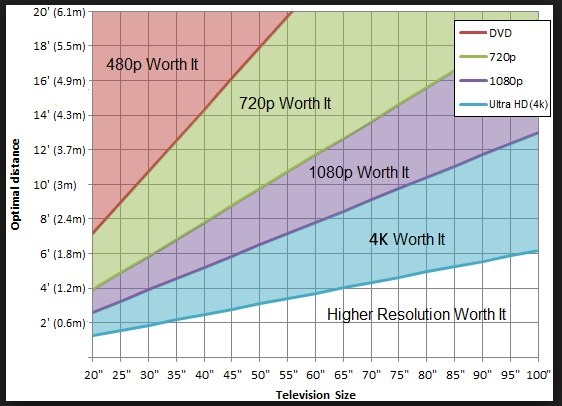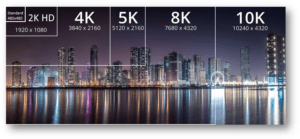

In the world of 2019, 4K screens (which also have HDR and other image enhancing technologies) cost only slightly more than 1080P (aka. 2K) screens so that is what most people should buy but don’t expect too much from it unless you are:


Most humans can see only a very minor improvement in picture quality between 1080 and 4K screens. This is because a 4K screen has about 8.3 million pixels but the human eye has only about 6 million “cones” which see color. Of those 6 million cones, there are blind spots and focus area’s which further diminish the effective input of the human eye. (See the video at the bottom of this post)
In the most straight forward terms you need to be looking at an extremely large screen for the human eye to detect a difference between a 1080P. For example, each pixel on a 60″ 4K screen is .3 milometers (.01 inches) wide. On a 60″ 1080 (2K) screen, which was the norm in 2018, each pixel is 1.2 mm (.04″) wide and the human eye just can’t see much of a difference.
To see such tiny pixels, the screen has to be massive or you have to be just a few inches from the screen. If you are trying to watch TV, you should be sitting back 5′ to 10′ from the screen so the only place that a ultra high resolution screen has value is in a corporate setting. Think about a boardroom that is used to display very high resolution graphics, like seismic data, which people want to get very close to for a few minutes.
If you have a 100″ screen, the average human eye would definitely perceive the difference. However most consumers have topped out at 55″-ish screens and that is expected to continue.
As you can see in the graph below, 8K screens exist today but even by 2025 they will have only very limited adoption.
It’s not that size and resolution don’t count; it is that the vast majority of TV’s sold in North America are 40′ to 60′ and have little price deltas between the 1080 (2K) and 4K models. So 50″-ish, 4K screens are the sweet spot for price / performance.
What really counts is the number of times per second that the screen displays a new image, aka Frame Rate. Humans see continuously and not in “frames” but somewhere beyond 100 refreshes per second, we just can’t perceive the difference.
Below 100 fast moving images, like a car chase or a hand movement may seem choppy or blurred. This is because most movies are shot at just 30 frames per second and that just is not enough for fast moving content. Nearly all TV screens sold in 2019 can operate at 60 frames per second and many can operate at 120 FPS.
So to sum it up, you are likely to buy a 4K screen that is not much better than your old 2K (1080P) screen, but the frame rate is something that will really make a difference to you.
To understand all this in a much more fun way than reading this page, take a look at this awesome video demonstrates that 4K / 8K generally does not improve general TV content but the frame rate really matters:
This website uses cookies.
View Comments
Frankly im fine with my 32 inch 1080p 3DTV. I don't need a movie theater in my house. Besides is batter at that anyways.
wack